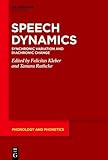Speech Dynamics : Synchronic Variation and Diachronic Change / ed. by Felicitas Kleber, Tamara Rathcke.
Material type: TextSeries: Phonology and Phonetics [PP] ; 36Publisher: Berlin ; Boston : De Gruyter Mouton, [2024]Copyright date: 2024Description: 1 online resource (VI, 484 p.)Content type:
TextSeries: Phonology and Phonetics [PP] ; 36Publisher: Berlin ; Boston : De Gruyter Mouton, [2024]Copyright date: 2024Description: 1 online resource (VI, 484 p.)Content type: - 9783110765199
- 9783110765410
- 9783110765328
- 414
- online - DeGruyter
- Issued also in print.
| Item type | Current library | Call number | URL | Status | Notes | Barcode | |
|---|---|---|---|---|---|---|---|
 eBook
eBook
|
Biblioteca "Angelicum" Pont. Univ. S.Tommaso d'Aquino Nuvola online | online - DeGruyter (Browse shelf(Opens below)) | Online access | Not for loan (Accesso limitato) | Accesso per gli utenti autorizzati / Access for authorized users | (dgr)9783110765328 |
Frontmatter -- Contents -- On the nature of speech dynamics: approaches to studying synchronic variation and diachronic change -- Part 1: Empirical perspectives on diachronic change -- Fifty years of monophthong and diphthong shifts in Mainstream Australian English -- Coarticulation guides sound change: an acoustic-phonetic study of real-time change in word-initial /l/ over four decades of Glaswegian -- The impact of automated phonetic alignment and formant tracking workflows on sound change measurement -- One place, two speech communities: differing responses to sound change in Mainstream and Aboriginal Australian English in a small rural town -- Prosodic change in 100 years: the fall of the rise-fall in an Albanian variety -- Part 2: Factors conditioning synchronic variation -- Control of larynx height in vowel production revisited: a real-time MRI study -- Sheila’s roses (are in the paddick): reduced vowels in Australian English -- The future of the queen: how to pronounce “König✶innen” ‘gender-neutrally’ in German -- Synchronic variation and diachronic change: mora-counting and syllable-counting dialects in Japanese -- Reconstructing the timeline of a consonantal change in a German dialect: evidence from agent-based modeling -- Part 3: Theoretical approaches at the interface between synchronic variation and diachronic change -- On (mis)aligned innovative perception and production norms -- Phonological patterns and dependency relations may arise from aerodynamic factors -- Actuation without production bias -- Understanding the role of broadcast media in sound change -- Connecting prosody and duality of patterning in diachrony, typology, phylogeny, and ontogeny -- Index
restricted access online access with authorization star
http://purl.org/coar/access_right/c_16ec
The relationship between diachronic change and synchronic variation at the articulatory, auditory, acoustic and social level is one of the greatest puzzles in the study of language. Even though plentiful examples exist to suggest that dynamics of synchronic variation and diachronic change are tightly interconnected, a unified theory to account for language change in its relationship to all layers of synchronic variation remains a desideratum. This volume compiles new evidence from articulatory, acoustic, auditory, sociolinguistic, and phonological analyses of segmental and prosodic data and computational modelling, and offers a refreshing theoretical angle on the ongoing debates in language change. The volume is divided into three sections, each focusing on one aspect of speech dynamics – the historical, the emerging and the theoretical, each making a step toward a unified view of speech dynamics at the interface of synchronic variation and diachronic change. The large range of methodologies and theories represented in this book will appeal to scholars from a variety of linguistic fields with an interest in speech dynamics, including phoneticians, phonologists, sociolinguists, typologists, computational and historical linguists.
Issued also in print.
Mode of access: Internet via World Wide Web.
In English.
Description based on online resource; title from PDF title page (publisher's Web site, viewed 20. Nov 2024)


